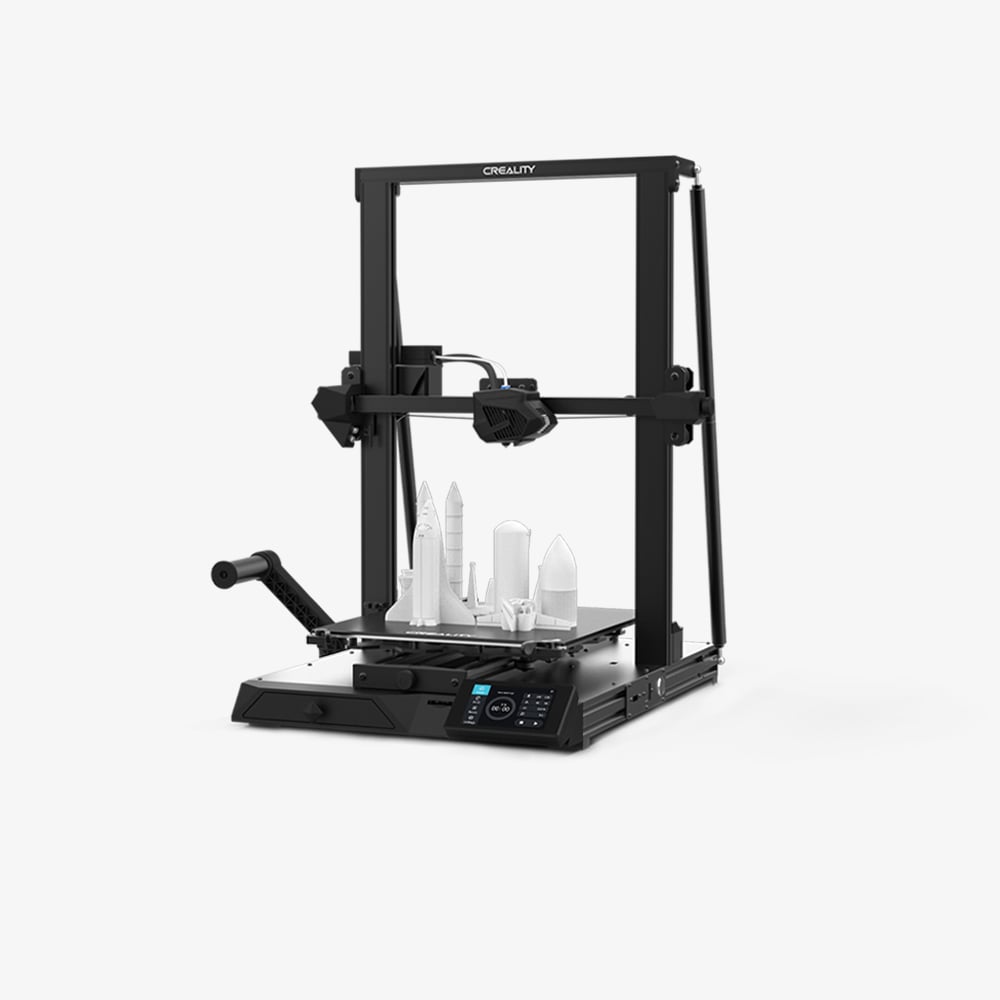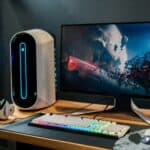The Creality CR-10 has established itself as a popular choice in the 3D printing community since its release. This large-format 3D printer offers an impressive build volume that appeals to hobbyists and creators who need to print bigger models. The CR-10 delivers reliable performance at an accessible price point, making it an excellent entry option for those looking to explore larger-scale 3D printing without breaking the bank.
Over the years, the CR-10 line has expanded to include several variants like the CR-10 Smart and CR-10 SE, each adding new features while maintaining the core benefits of the original design. The CR-10 Smart introduces intelligent auto-leveling and WiFi connectivity, while the CR-10 SE supports a wide range of filament types including high-temperature and flexible materials. These printers utilize Fused Filament Fabrication (FFF) technology, the most common method in consumer 3D printing.

The modular design of the CR-10 series makes it ideal for those who enjoy upgrading and modifying their equipment. Many users start with the base model and gradually enhance it with aftermarket parts, creating a customized printing experience that grows with their skills and needs. This upgradeability factor has contributed significantly to the printer’s enduring popularity in a rapidly evolving market.
Review
The Creality CR-10 is a highly popular 3D printer known for its large build volume, making it ideal for users who want to print bigger models without splitting them into parts. It offers a build size of 300 x 300 x 400 mm in its standard version, with larger variants available. This spacious print area is one of its standout features, especially at its price point.
Users appreciate the CR-10 for its decent print quality and good print speed. The printer features a sturdy frame and an improved Z-axis design, which contributes to stable and reliable printing. Its straightforward setup and user-friendly interface make it accessible for both beginners and more experienced makers.
However, some users note that while the CR-10 delivers great value, it may require occasional tinkering or upgrades to optimize performance fully, which is common in budget-friendly 3D printers. The community support around the CR-10 is strong, with many resources available for troubleshooting and modifications.
Overall, the Creality CR-10 remains one of the best machines in its price range, especially for those prioritizing large print volume and solid performance without breaking the bank.
| Feature | Rating (1-10) |
|---|---|
| Build Volume | 9 |
| Print Quality | 7 |
| Print Speed | 7 |
| Frame Stability | 8 |
| Ease of Setup | 7 |
| User Interface | 6 |
| Community Support | 9 |
| Value for Money | 8 |
| Overall Score | 7.6 |
The Creality CR-10 scores highly for its large build volume and strong community support, making it an excellent choice for budget-conscious users needing bigger prints. Its print quality and speed are solid but may require some tweaking for optimal results. Overall, it offers great value in its category.

Key Takeaways
- The CR-10 offers large build volume and reliable performance at an affordable price point for entry-level and experienced users alike.
- Modern variants like the CR-10 Smart include advanced features such as auto-leveling and wireless connectivity for improved user experience.
- The modular design makes the CR-10 highly customizable, allowing users to upgrade components as their skills and requirements evolve.
Design and Build Quality
The Creality CR-10 combines large-scale printing capabilities with a sturdy frame design that provides stability during extended print jobs. The printer’s open-frame construction offers easy access to components while maintaining structural integrity essential for precise printing.
Dimensions and Weight
The CR-10 features a substantial footprint with overall dimensions that accommodate its impressive build volume. The printer consists of two separate units: the main printer frame and a control box housing electronics. This split design helps distribute weight while providing easier access for maintenance.
The printer weighs approximately 11-13 kg total, making it heavier than many desktop models but still manageable for most workspaces. Its aluminum frame contributes to the weight but provides necessary rigidity during operation.
Despite its size, the CR-10’s design allows it to fit on a standard desk or workbench. The separate control box can be positioned alongside or behind the main unit to optimize workspace arrangement.
Build Surface and Volume
The CR-10’s standout feature is its generous build volume of 300 x 300 x 400mm (11.8 x 11.8 x 15.7 inches), significantly larger than typical desktop 3D printers. This expanded capacity allows for printing large single-piece models that would require assembly if printed on smaller machines.
The build surface uses a heated aluminum bed covered with a removable sheet. The bed can reach temperatures of about 100°C, suitable for printing various materials including PLA, ABS, and TPU. Bed adhesion is generally good, though many users add additional surfaces like PEI sheets for improved first-layer results.
The bed leveling is manually adjusted using four corner thumb screws. While not as convenient as automatic systems, this design is reliable and straightforward to maintain.
Stability Features
The CR-10’s frame uses 20x40mm and 20x20mm aluminum extrusions arranged in a cube structure, providing excellent rigidity during printing operations. This robust frame minimizes vibrations that could affect print quality, particularly important given the printer’s large build volume.
Z-axis stability is enhanced through dual lead screws that move the X-axis gantry up and down. This dual-lead screw design helps prevent z-wobble issues that can affect print quality on tall objects.
The printer includes adjustable tension belts for both X and Y axes. These can be tightened to reduce slack and improve dimensional accuracy. Cable management is simplified through bundled wires and protective sleeves, reducing interference with moving parts during operation.
Printing Capabilities
The Creality CR-10 offers versatile printing capabilities that make it suitable for both beginners and experienced users. Its robust design and quality components contribute to reliable performance across various printing scenarios.
Material Compatibility
The CR-10 supports a wide range of filament materials, making it versatile for different projects. PLA works exceptionally well as the default material, requiring no heated bed and producing clean prints with minimal issues.
For more advanced users, the printer handles ABS effectively when using the heated bed at temperatures around 100°C. The CR-10 also processes PETG with excellent results, offering a good balance between strength and ease of printing.
TPU and flexible filaments can be printed, though at slower speeds due to the Bowden extruder setup. With the proper nozzle, the CR-10 can even handle specialty filaments like carbon fiber-infused materials, though these may cause faster nozzle wear.
The industrial-grade PCB allows for extended printing sessions—reportedly up to 200 hours continuously without pressure, according to search results.
Layer Height and Resolution
The CR-10 delivers impressive resolution capabilities that satisfy most printing needs. Standard layer heights range from 0.1mm to 0.3mm, with 0.2mm offering the best balance between quality and speed for everyday prints.
For highly detailed models or miniatures, the printer can achieve layer heights as low as 0.05mm, though print times increase significantly. The standard 0.4mm nozzle provides good detail for most applications.
Users can upgrade to smaller nozzle diameters (0.2mm or 0.3mm) for extremely fine details or larger ones (0.6mm or 0.8mm) for faster printing with less detail. The printer’s stable frame contributes to consistent layer adhesion and dimensional accuracy.
Search results mention “very fine print capabilities,” confirming the CR-10’s reputation for quality resolution output.
Printing Speed and Quality
The CR-10 balances speed and quality effectively for various printing needs. Typical printing speeds range from 40-60mm/s for standard quality prints. For detailed work, reducing to 30-40mm/s produces noticeably better results.
The printer can reach speeds up to 100mm/s for draft-quality prints or non-visible internal structures. The CR-10 Smart version features ultra-silent operation for more pleasant printing experiences, especially during long jobs.
Print quality remains consistent due to the printer’s rigid frame design that minimizes vibrations. The auto-leveling feature found in newer models like the CR-10 Smart helps maintain quality by ensuring proper first layer adhesion.
The separated control box (mentioned in search results) contributes to stability by reducing moving mass on the frame. The CR-10 SE model includes a hardened steel nozzle that enables printing at temperatures up to 300°C, expanding material options.
Advanced Features
The Creality CR-10 series printers come equipped with several sophisticated features that enhance print quality and user experience. These features make the printing process more reliable, convenient, and efficient for both beginners and experienced users.
Auto-Leveling System
The CR-10 Smart models include an intelligent auto-leveling system that significantly improves first layer adhesion. This BL Touch system automatically measures the print bed at multiple points to create a precise height map of the surface.
The printer compensates for any slight variations in bed level during printing. This eliminates the frustrating manual leveling process that often leads to failed prints.
Auto-leveling is particularly valuable when working with larger prints that cover more of the bed surface. Users can activate the auto-leveling feature through the touchscreen interface or remotely via the connected app.
The system also helps maintain consistent calibration over time, even as the printer components naturally shift with regular use.
Filament Monitoring
CR-10 printers feature advanced filament monitoring capabilities that prevent print failures and material waste. The filament runout sensor detects when material is exhausted and automatically pauses the print job.
This allows users to load new filament and resume printing without starting over. The system works with various filament types including PLA, ABS, PETG, and TPU.
The CR-10 also includes power loss recovery functionality. If electricity is interrupted during printing, the printer saves its position and settings. When power returns, users can pick up exactly where they left off.
These monitoring systems are especially valuable for lengthy prints that may take several hours or even days to complete. The features provide peace of mind during overnight or unattended printing sessions.
Connectivity Options
CR-10 models offer multiple connectivity options that enhance convenience and workflow efficiency. The printers support Wi-Fi connectivity, allowing users to monitor and control prints remotely through the Creality Cloud app.
The app provides real-time status updates and lets users adjust settings from anywhere. Some models also include an integrated camera for visual monitoring of print progress.
For direct connections, the printers feature USB ports for transferring files and firmware updates. Selected models include RJ45 Ethernet ports for stable network connections in professional environments.
The touchscreen interface provides intuitive local control with easy access to printer settings and diagnostics. These connectivity options make the CR-10 suitable for both home and small business use, offering flexibility in how users interact with their printer.
Creality Ecosystem and Software
The CR-10 3D printer is supported by a robust ecosystem of software solutions that enhance its functionality and user experience. These range from Creality’s proprietary applications to third-party slicing software and community-developed firmware options.
Creality Cloud Integration
Creality Cloud serves as the manufacturer’s online platform for CR-10 users. It allows for remote monitoring and control of prints from mobile devices or computers. Users can access a library of 3D models, many optimized specifically for CR-10 printers.
The platform supports wireless file transfers to compatible CR-10 models like the CR-10 Smart and CR-10 Smart Pro. This eliminates the need for SD cards or USB connections for many printing tasks.
Creality Cloud also facilitates community engagement through model sharing and troubleshooting forums. This creates a collaborative environment where CR-10 users can exchange ideas and solutions.
Slicing Software Compatibility
The CR-10 works with multiple slicing software options. Creality Print, the manufacturer’s official slicer, comes with pre-configured profiles for the CR-10 family of printers, making setup straightforward for beginners.
Cura, a popular free slicing program, offers extensive customization for CR-10 users. It supports STL, OBJ, and 3MF file formats and includes CR-10 printer profiles in its library.
Other compatible options include:
- PrusaSlicer: Open-source with powerful features
- Simplify3D: Premium paid software with advanced support settings
Each slicer offers different strengths for CR-10 users, from Cura’s accessibility to Simplify3D’s precision control for complex prints.
Firmware and Community Support
The CR-10 benefits from both official and community-developed firmware. Creality regularly releases firmware updates for models like the CR-10 Smart (currently at v1.0.14 for the CRC2405V1.2 motherboard) to improve performance and add features.
The printer’s open-source approach, recognized by the Open Source Hardware Association, has fostered a vibrant community. This openness makes CR-10 models highly customizable through third-party firmware options.
Community modifications often add features like mesh bed leveling, improved thermal management, and interface enhancements. Online forums and social media groups provide valuable resources for firmware updates and troubleshooting.
Community support extends the CR-10’s lifespan by addressing issues that official channels might not cover.
Frequently Asked Questions
The Creality CR-10 series generates many common questions from both new users and experienced 3D printing enthusiasts. These questions cover everything from model differences to material compatibility and potential upgrades.
What are the differences between the various models of the Creality CR-10 series?
The CR-10 series includes several models that differ in build volume, features, and price points. The standard CR-10 offers a 300x300x400mm build volume, while the CR-10S adds dual Z-axis lead screws for better stability and a filament sensor.
The CR-10S Pro incorporates an automatic bed leveling system and a touch screen interface. The CR-10 Max provides the largest build volume in the series at 450x450x470mm.
The newer CR-10 Smart features Wi-Fi connectivity and app control capabilities. Each model targets different user needs while maintaining the classic CR-10 frame design.
How does the print quality of the Creality CR-10 compare with other leading 3D printers in the market?
The CR-10 delivers impressive print quality for its price range, competing effectively with printers costing significantly more. With proper calibration, it can achieve layer resolutions as fine as 0.1mm.
When compared to other budget-friendly options like the Ender series, the CR-10 typically offers better dimensional accuracy due to its more rigid frame. However, it may require more tweaking than premium brands like Prusa or Ultimaker to achieve comparable results.
Many users report that after minor upgrades and adjustments, their CR-10 printers produce results nearly indistinguishable from those of higher-end machines.
Can the Creality CR-10 handle high-temperature materials like ABS and nylon?
The standard CR-10 can print basic ABS with some limitations. Its heated bed reaches approximately 100°C, which is at the lower end of what’s needed for ABS adhesion and warp prevention.
For reliable nylon printing, upgrades are typically necessary. These include an all-metal hotend, enclosure, and possibly a more powerful power supply to maintain higher temperatures.
The CR-10S Pro and newer models come better equipped for high-temperature materials with improved hotends and more powerful heated beds. An enclosure is still recommended for the best results with warping-prone materials.
What upgrades are available for the Creality CR-10 series, and how do they enhance printer performance?
Popular CR-10 upgrades include all-metal hotends that allow for higher temperature printing. Direct drive extruder conversions improve flexible filament handling and retraction performance.
Bed leveling sensors like the BLTouch make the calibration process much easier. Stiffer bed springs reduce the frequency of manual leveling, while silicon thermal pads provide more even heat distribution.
Many users also upgrade the cooling system with improved fan ducts. Mainboard upgrades to 32-bit systems with silent stepper drivers significantly reduce noise while improving motion control precision.
What is the maximum build volume available within the Creality CR-10 series?
The CR-10 S5 offers a substantial 500x500x500mm build volume, making it ideal for large-scale projects. The CR-10 Max provides 450x450x470mm of printing space.
The standard CR-10 features a 300x300x400mm build area, which exceeds most competitors in its price range. The CR-10 Mini offers a smaller 300x220x300mm option for those with space constraints.
These large build volumes represent a key selling point for the CR-10 series, particularly for users creating cosplay items, functional prototypes, or architectural models.
How does the Creality CR-10’s ease of assembly and operation compare to its competitors?
The CR-10 comes partially assembled, requiring about 30-60 minutes to complete setup. This semi-kit approach makes it easier to assemble than complete DIY kits while allowing users to understand printer mechanics.
The printer features a straightforward interface with an LCD control panel. Newer models like the CR-10 Smart and CR-10S Pro include touchscreens that simplify operation.
When compared to plug-and-play options like the Prusa Mini or Flashforge Adventurer, the CR-10 requires more initial setup and calibration. However, many users appreciate this learning experience as it helps with troubleshooting and maintenance later on.







